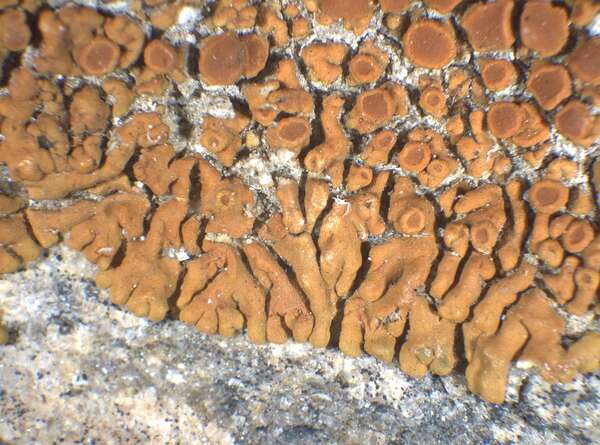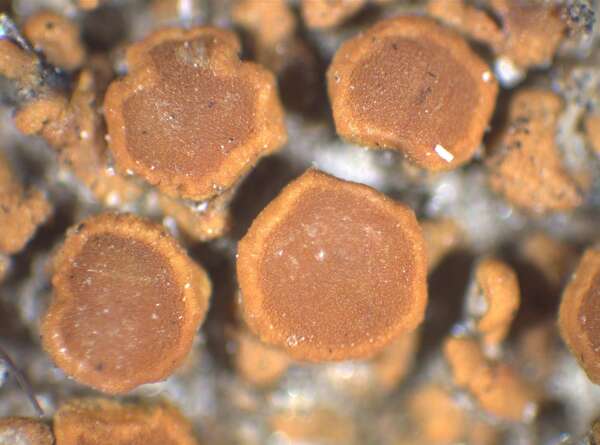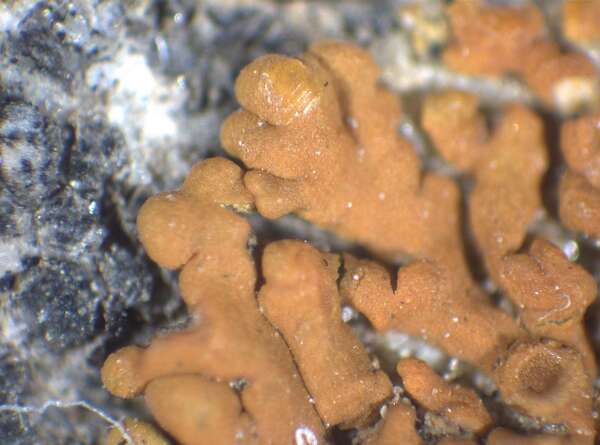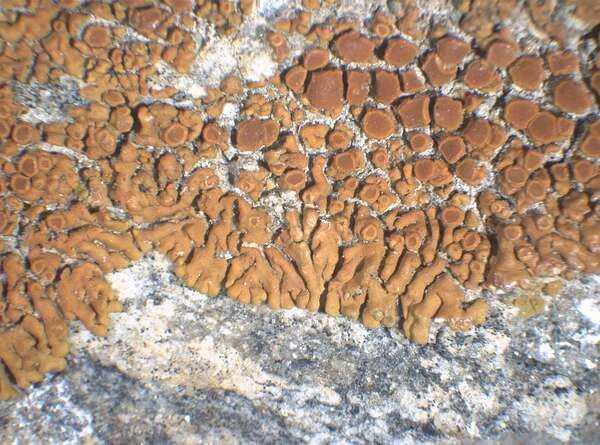Variospora aegaea (Sipman) Arup, Frödén & Søchting
in Arup & al., Nord. J. Bot., 31: 76, 2013. Basionym: Caloplaca aegaea Sipman in Sipman & Raus - Willdenowia, 32: 366, 2002.
Synonyms:
Distribution: C - Tosc (Herb. Vondrák 8823). Sar (Sipman & Raus 2002).
Description: Thallus crustose-placodioid, episubstratic, orange, epruinose, the central part consisting of 0.2-1 mm wide, convex areoles, the marginal lobes somehow waxy and shiny, convex, 0.5-1.5 mm wide, rather loosely attached, irregular, often sinuous, adjacent or sometimes overlapping, forming orbicular to irregular, often confluent rosettes. Apothecia zeorine, sessile, 0.3-0.6 mm across, with a flat to slightly convex, epruinose, orange-brown disc, and a paler, persistent margin. Thalline exciple corticate, well-evident only in young apothecia, later confined to the basal parts; proper exciple up to 100 μm wide, the medulla colourless, of radiating hyphae; epithecium orange, K+ red; hymenium colourless, 60-80 μm high; paraphyses simple or sparingly branched, c. 2 μm thick at base, the apical cells 2.5-5 μm wide; hypothecium colourless. Asci 8-spored, clavate, functionally unitunicate, apically thickened with a broad internal beak, the inner part of apex and external cap I+ blue, Teloschistes-type. Ascospores 2-celled, polarilocular, hyaline, the mature ones rhomboid, 11-14 x 6-8 μm, the equatorial thickening (“septum”) 3-5 μm. Pycnidia orange, immersed. Conidia bacilliform, c. 3 x 0.5 μm. Photobiont chlorococcoid. Spot tests: thallus and apothecia K+ red, C-, KC-, P-. Chemistry: thallus and apothecia with parietin (major), fallacinal, emodin, teloschistin and parietinic acid (minor), corresponding with chemosyndrome A of Søchting (1997).Note: a recently-described, mostly coastal species of base-rich or calciferous siliceous rocks, probably more widespread in Mediterranean Italy.
Growth form: Crustose placodiomorph
Substrata: rocks
Photobiont: green algae other than Trentepohlia
Reproductive strategy: mainly sexual
Commonnes-rarity: (info)
Alpine belt: absent
Subalpine belt: absent
Oromediterranean belt: absent
Montane belt: absent
Submediterranean belt: absent
Padanian area: absent
Humid submediterranean belt: absent
Humid mediterranean belt: very rare
Dry mediterranean belt: very rare

Predictive model


P.L. Nimis; Owner: Department of Life Sciences, University of Trieste
Herbarium: Herb. Sipman (B)
2003/01/23
holotypus


P.L. Nimis; Owner: Department of Life Sciences, University of Trieste
Herbarium: Herb. Sipman (B)
2003/01/23
holotypus
Growth form: Crustose placodiomorph
Substrata: rocks
Photobiont: green algae other than Trentepohlia
Reproductive strategy: mainly sexual
Commonnes-rarity: (info)
Alpine belt: absent
Subalpine belt: absent
Oromediterranean belt: absent
Montane belt: absent
Submediterranean belt: absent
Padanian area: absent
Humid submediterranean belt: absent
Humid mediterranean belt: very rare
Dry mediterranean belt: very rare

Predictive model


P.L. Nimis; Owner: Department of Life Sciences, University of Trieste
Herbarium: Herb. Sipman (B)
2003/01/23
holotypus


 INDEX FUNGORUM
INDEX FUNGORUM
 GBIF
GBIF



